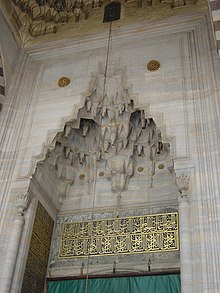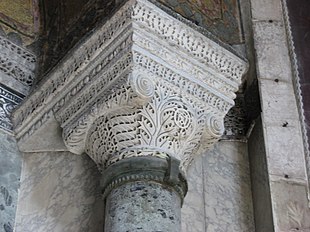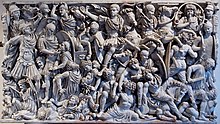Prokonnesian marble
Coordinates: 40 ° 38 ′ 24.6 " N , 27 ° 37 ′ 56.2" E



The Prokonnesian marble or Marmara marble is a high-quality marble that has been mined on the Turkish island of Marmara (Greek name Prokonnesos) for over 2,000 years . It appears in the color gradations plain snow white to light gray, which is mainly used artistically for statues, and white with gray banding, which is mainly used for arts and crafts and architecture due to the attractive grain.
Occurrence
The island of Marmara is located in the Marmara Sea of the same name between the Aegean Sea and the Bosporus . It belongs to the Turkish province of Balıkesir .
The quarries are mainly located near the port of Saraylar. Others are spread over the northern half of the island. The relevant area extends over an area of forty square kilometers.
Geology, formation, properties
The main deposit of this crystalline marble is in the northern part of the island. In the southern half of the island, there are other marbles that are not subject to degradation and mainly belong to the Erdek complex (a regional geological formation ).
The island's marble deposits are cut by a west-east trending train of granodiorites ( Gündoğdu complex ). They also accompany metamorphic rocks in the contact zones , such as mica-containing schisto gneiss and orthogneiss. In the north, d. H. in parts of the shore zone lying on marbles foliated sandstones and limestones layered (Shale), accompanied by individual quartz - and Feldspateinlagerungen on.
Near the shore zone, the deposit falls at a slope of 30 to 35 °. Their inclination increases in a southerly direction and reaches a maximum of 50 ° in the contact zone with the granodiorites. In its horizontal extent, the deposit reaches a width of 2.5 to 3.5 kilometers and in the vertical it should be about 300 meters thick. Isolated dolomite deposits occur in a lenticular form .
The formation of these deposits is classified in the period from the Triassic to the Upper Paleozoic, i.e. about 251 million years ago. Because a complete metamorphosis has taken place, the fossil components necessary for a more accurate determination of the age are missing .
Prokonnesian marble is a medium-grain crystalline carbonate rock with a white basic color. There are parallel gray bands in different distribution. Some gray structures are described as blue-gray in the literature. These bands are created by finely divided graphite , organogenic material, iron oxides and sulfides, other submicroscopic inclusions and other factors that ensure that the light transmission at the grain boundaries is disturbed. Its typical composition can be seen from the following analysis values (in percentages by mass):
- CaO 55.25, MgO 0.72, SiO 2 0.01, Fe 2 O 3 <0.15, carbonate residue approx. 43.0.
A white-gray variety without ribbon structures has been popular for statues since ancient times.
By processing it takes on a good polish. Many ancient components and fragments prove its excellent weather resistance. Its porosity value is 0.2 percent.
History, forms of application
The start of quarrying work on Marmara cannot be precisely dated. The first extraction activities are recorded for the 1st century AD. The Roman writer Vitruvius gives certain information that marble was used as early as the 4th century BC. In the construction of the palace of Mausolus in Halicarnassus was used. The Milesians are also said to have used this raw material.
For Pergamon, the early use of proconnesian marbles for the frieze of the Temple of Demeter (281–263 BC), the temple on the Upper Market (Geison, under Attalus I, 3rd century BC) and the Pergamon Altar (Telephosfrieze and Great Frieze, 170 BC).
The ancient use of Prokonnesian marble was just as extensive as with comparable other marbles from the Mediterranean region. These include architectural parts , statues , fountain basins , capitals , columns , sarcophagi and wall reliefs in many parts of the Roman Empire .
Many fragments of ancient columns have been preserved on Marmara, which either broke during processing or did not reach their destination for other reasons. An inventory of these fragments showed that column blanks with a diameter between 40 and 90 centimeters were typically produced.
Since late antiquity, many finished marble products and semi-finished products have been transported by ship from the small port of Saraylar to nearby and distant places of the Roman Empire. In Istanbul , archaeologists found half-finished columns made of this marble. This proves the division of labor distribution of this stone.
In the Middle Ages, the importance of these quarries meant that the whole island of Marmara was first named, and later the surrounding sea was also called the Sea of Marmara. Prokonnesian marble was also quarried during the Ottoman period and was used in many buildings both inside and outside. Columns, capitals, entire manabir and mihrabs in mosques have been made from this magnificent, elegant stone.
Since the late 19th century it was used for tombstones , bathroom fittings and floor tiles in Constantinople . In the 20th and 21st centuries, various companies exported around the world.
The history of marble mining and its processing extends continuously over the Greek, Roman, Byzantine , Ottoman and modern Turkish cultural epochs. Such continuous transcultural acceptance with significant architectural and artistic preferences can only be seen in a few natural stones in the Mediterranean area. In this sense Prokonnesian marble occupies an unusual position among marbles.
Collections in Marmara Island
A small open-air museum ( Marmara Müzesi ) in the port town of Saraylar shows applications of marble from ancient eras collected on the island through fragments of the Roman and Byzantine eras. Unfinished architectural parts, some of which are still marked with stonecutter marks, illustrate the working techniques.
In the vicinity of several active quarries, there is an outdoor area each showing old and modern work from the respective mining site. These areas look like a "marble garden".
Varieties and Competing Marbles
Today the marble is available internationally under the trade name Marmara and with other names. A distinction is essentially made according to the coarse grades white, light gray and striped.
All light, medium-grain marbles from the Mediterranean region can be regarded as competing marbles.
use
Berlin
Istanbul
- Hagia Sophia (numerous architectural parts, including Byzantine capitals)
- Sultan Ahmed Mosque
- Theodosius Forum (remains of the triumphal arch)
- Suleymaniye Mosque
- Topkapı Palace
Pergamon
- Demeter Temple (frieze)
- Pergamon Altar (large frieze and Telephos frieze)
- Trajan Temple (pillars of the north hall)
See also
Individual evidence
- ↑ Naturel Stones of Turkey. turkishtime sectors (undated, approx. 2000)
- ↑ Thomas Cramer: Multivariate analysis of the origin of marble ... 2004, p. 188.
- ↑ Kai Michel: The battle of the gods against rust. In: Zeit-online. 12/2003.
literature
- N. Asgari: Observations on two types of quarry items from Proconnesus: column shafts and column bases. In: Marc Waelkens, Norman Herz, Luc Moens: Ancient stones: Quarrying, Trade an Provenance. (= Acta archaeologica lovaniensia. 4). Leuven 1992, ISBN 90-6186-494-1 , pp. 73-80.
- Gabriele Borghini (ed.): Marmi antichi . Edizioni de Luca, Roma 2001, ISBN 88-8016-181-4 .
- Thomas Cramer: Multivariate analysis of the origins of marble on a petrographic and geochemical basis - the example of archaic, Hellenistic and Roman marble objects from Asia Minor from the Berlin Collection of Antiquities and their assignment to Mediterranean and Anatolian marble deposits. Dissertation . Research Institute for Mineral Storage Research , Berlin 2004, DNB 972710817 .
- Norman Herz: Stable isotope applications to problems of classical Greek an Roman marbles: provenance, authenticity and assembly of artifacts. In: Entretiens d'archéologie et d'histoire, Les marbres blancs de Pyrénées. Saint-Bertrand-de-Comminges 1995, ISBN 2-9502446-7-X .
- Ferdinand von Hochstetter: Geological overview map of the eastern part of European Turkey . Scale 1: 1,000,000, lith. F. Köke, Vienna 1870.
- Gercek Saraç: Marmara Adası ve Kapıdağı Yarımadasının Stratigrafisi. In: TPJD Bülteni, C7 s. 33-49 Aralık 1995.



